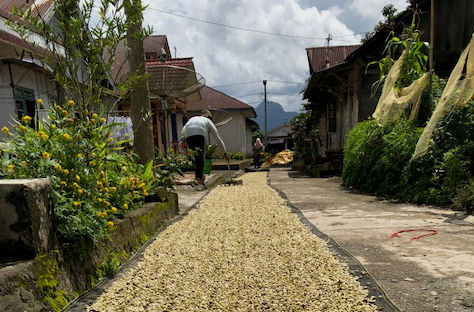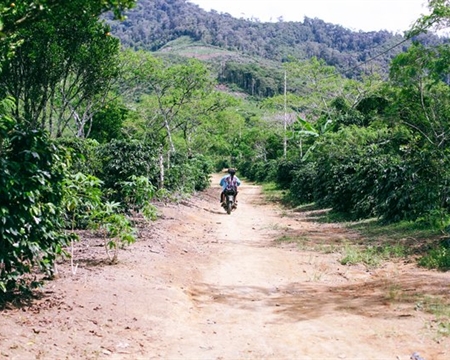- You cannot add "Ethiopia Sidamo Grade 2 EA Coffein Decaf" to the cart because the product is out of stock.
Sumatra Kayu Aro Yudi Putra Mill Wet Hulled Crown Jewel
Boxes 0
Warehouses Oakland
Out of stock
intro
A sparkling clean and yet still very classic Sumatran coffee here, sourced, milled, and exported by our long-term partners at Yudi Putra Mill. At longer roasts it’s quite herbal and loaded with molasses, fudge, and cedar, while quick, light roasts bring forward less earth and more vanilla and almondy sweetness with a surprising amount of fruit: lime, tamarind, green grape, and green apple.
Kayu Aro is the name of the village from which this coffee comes, grown by members of the ALKO cooperative, a new group centered near Mount Kerinci in west-central Sumatra, in the Jambi Province. Starting in 2014 with 120 members, the cooperative has more than doubled in size in less than 5 years, now representing nearly 300 farming families and covering almost 400 hectares. The cooperative also produces potatoes and has a tourism office.
In standard Sumatran fashion, this coffee has been wet hulled before drying completely, a practice called Giling Basah locally. The practice arose from Indonesia’s earliest days of cultivation under the Dutch colonizers, and is as pragmatic an exchange as exists in the coffee growing world, minimizing labor and time at the front end of the supply chain while still adding value. This method leaves its mark on the distinctive jade-like color of Sumatran coffees, as well as their funky, earthy flavors, unmatched elsewhere on the globe.
green
Great moisture numbers accompanied by a very stable water activity are a pleasant surprise from this Sumatran selection, a rarity for this processing style which can frequently leave the green coffee vulnerable to drying problems. A little below average in density and a little above average in screen size, the coffee tacks closely with other regional offerings in these regards.
The farmers in Kayu Aro are growing a variety known as Linie S 795, also called Jember. The “S” in Linie S stands for selection, while Jember is both the name of a regency in East Java, the location of a research station through which the cultivar was distributed. The coffee was originally bred in India for rust resistance, and includes some interesting lineage. It’s a hybrid, one parent being Kent, arabica’s very first rust resistant selection (also of Indian heritage). Its other parent is S228, an unromantic name for a spontaneous interspecific hybrid of arabica and west Africa’s indigenous liberica coffee species.
taste
ikawa
Knowing that Sumatra coffees are larger in screen size than most coffees and usually have quite a bit of moisture, I knew that I needed to employ one of my longer profiles on the Ikawa roaster. Even with a long roast profile of 5:45, which is longer in scope than my average sample roast, the beans barely hit first crack in the last ten seconds and appeared mottled in color after roasting. I was worried that the coffee was underdeveloped, so I increased the total roast time on Roast 2 to 6:30 and increased the end temperature to 412F.
On the cupping table, Roast 1 had a bright acidity with lots of juicy citrus balanced by caramel and maple syrup. Roast 2 never fully reached first crack, but still had plenty of time to develop sugar browning flavors. On the cupping table there was lots of cooked fruits like peaches and golden raisin with traditional dark chocolate and tobacco flavors that are adored in Indonesian coffees.
probatino
In the chaos of opening the Crown, our usual analysis routine has been thrown into a bit of disarray. While Jen was introducing our newly hired barista staff to the nuances of heat transfer in roasting equipment, I took the opportunity to knock out two quick roasts of this Sumatra on the Probatino.
My lapse in practice became quickly apparent on the first roast when I tried to slightly extend both drying and Maillard and ended up with a pretty slow roast. I had to push the gas up a little higher than intended right before coloring and even so didn’t hit first crack until 8:31. Already longer than intended, I hit cruise control at first crack and let the development edge up to about 100 seconds. Classic Sumatra flavors like cedar and herbs with some sugar browning notes and hints of roast dominated the flavor notes for this first try (blue). I figured I got about what I paid for here, nothing spectacular but thoroughly drinkable and developed sufficiently for espresso applications as an omni-roast.
Roast number 2 (red) started hotter and I punched the gas a little earlier, which gave me a nice looking curve and a gentle steady downslope in my heat delta prior to first crack (which was more vigorous and compact) starting to pop a bit hotter than Roast 1 and just before the 6 minute mark. Targeting a lighter roast style, I dropped the still lightly crackling beans into the tray after about 70 seconds of development. Unexpectedly bright acidity on the cupping table was met with a lighter body but cleaner mouthfeel and a lot of nuanced soft fruit and sweet vanilla and sarsaparilla flavors. A wet hulled option for the washed coffee lover if I’ve ever seen one, and delightful as filtered drip.
brew
This coffee can pack some really great acidity, clean fruit flavors, and almond sweetness under the right circumstances. Although it was a little bit of a struggle to dial out some of the cedar and tobacco notes from Chris’s first roast (in blue above), even in the most loosely dialled cups this wet-hulled coffee from Kayu Aro offered flavors of strawberry, vanilla, meyer lemon, and cocoa.
Using two different pour over methods n (the Stagg Dripper from Fellow and the December Dripper), and two relatively long brew ratios (1:16 and 1:17 respectively) yielded a pleasantly tealike cup featuring green apple, cherry, vanilla, a light body, and a cedar finish. On the Aeropress with a very short ratio and a very concentrated ratio (1:10), we found a punch of fruit acids, cocoa butter, and a really smooth body. Pushing this coffee to the extremes proved that even under high extraction, this Sumatra can make a delicious cup.






